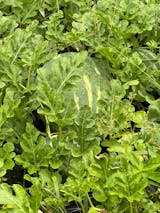
Tendersweet Orange Watermelon
$4.20
100%
Non-GMO
Free
Shipping
Service
Guaranteed
Also Known As: Tendersweet Melon, Orange-Flesh Tendersweet, Golden Tendersweet, Orange Sweet Watermelon, Heirloom Orange Watermelon, Sunset Melon, Amber Watermelon, Orange Delight Melon, Tangerine Watermelon, Citrus-Flesh Watermelon.
| Plant Name: | Watermelon, Tendersweet Orange |
| Latin Name: | Citrullus lanatus |
| Days to Germinate: | 7-14 |
| Days to Harvest: | 80-100 |
| Plant Height: | 1 - 2 Feet |
| Spread: | 6 - 12 Feet |
| Growth Habit: | Vining |
| USDA Zones: | 3-12 |
| Lifespan: | Annual |
| Brand: | TomorrowSeeds |
| Sunlight: | Full Sun, Partial Shade |
| Pollination: | Heirloom, Open-Pollinated |
| GMO: | No |
| Fungicide-Treated Seeds*: | No |
| Seeds Packed For**: | 2025 |
**Seeds are freshly packed for the growing season of the year listed. Seeds are still viable beyond pack date. Store in a cool and dry location such as the refrigerator or basement to best preserve germination rates.
Planting Instructions:
Soil Preparation:
Choose an area with heavy, well-draining soil that receives at least 6 hours of sunlight each day. Remove weeds, large rocks, and litter from the planting area. Leave small weeds and dead grass, they will enrich the soil when turned under. Spade or till the soil 8-12 inches deep. Loosening the soil will help the plant establish strong roots.
Plants grow best in soil with lots of organic matter. You may optionally add fertilizer or organic material such as compost, leaves, or rotted hay to mix into the soil at this point. For small gardens, scatter 2-3 tablespoons of fertilizer evenly and work into the top 2-3 inches of soil for each hill or 2 foot by 2 foot planting area. For larger gardens, scatter 2-3 pounds of a complete fertilizer for each 100 square feet of planting area. Work fertilizer or organic material into the soil and leave the surface smooth.
Form rows of soil beds 4-6 inches high and at least 8 feet apart. This formation of ridges will help with drainage.
Planting:
Watermelons thrive in warm temperatures, with the ideal growing range being between 70F-85F. They require warm soil for germination, ideally around 70F or higher.Starting Indoors: For an earlier harvest, you may optionally start planting indoors in containers 2-4 weeks before the last expected frost date in Spring, keeping seedlings at least 70F. Harden off then transplant seedlings outdoors in a sunny location when the soil temperature is above 65F. To transplant seedlings, prepare a transplant hole outdoors in a sunny location. Remove the plants carefully from the pots or flats and set them in the holes, burying some of the stem in the ground. Pack the soil loosely around the plant and leave a slightly sunken area around each plant to hold water. Water the plants after transplanting. Optionally, Train plants to climb a 6-8 foot trellis or fence as they establish.
Directly Sowing: If directly sowing outdoors, plant in mid-late spring when the soil warms to at least 70F. Fall planting is not typically recommended unless planting in climates with mild winters (USDA Zones 9-11) - plant at least 3-4 months before the first expected frost date - or growing indoors at >70F using supplemental grow lights.
To plant, make holes 1 inch deep and spaced 4 feet apart down the rows of raised beds. Plant 2-3 seeds per hole. If choosing to thin to the strongest plant, determine the strongest and healthiest plant, then remove all other plants, narrowing to a single plant per hole. Cover seeds thinly with soil and water after planting. Optionally, train plants to climb a 6-8 foot trellis or fence as they establish, spacing plants 3 feet apart at the base. Watermelons may require support as they grow.
| Planting Depth: | 1-2 inches |
| Within-Row Spacing: | 4 feet |
| Between-Row Spacing: | 3 feet (trellis) or 8 feet (sprawl) |
Care During the Season:
Watering: Water the plants deeply, soaking the soil to a depth of 6-8 inches, once to twice a week. If there is no rainfall, water 3-4 times a week. Sandy soils may need to be watered more often than heavy clay soils. Mulching around plants can help retain moisture.
Weeding: Keeping plants weed-free improves production. If plowing or hoeing, do not dig deeper than 1 inch to prevent from cutting the feeder roots.
Fertilizing: Once seedlings are established, 2-3 weeks after germination, you may optionally apply 2 tablespoons of a complete fertilizer around each hole, or 1-2 pounds per 100 square feet, without letting the fertilizer touch the plants. Optionally, continue fertilizing every 3-4 weeks as plants grow, especially after flowering begins. Water plants after fertilizing.
Insecticides: Insecticides may be used to protect plants. Bt-based insecticides and sulfur are organic options that can be used for prevention. Sulfur also has fungicidal properties and helps in controlling many diseases. Before using a pesticide, read the label and follow cautions, warnings and directions.
Diseases: If spots or mold appear, treat plants with an approved fungicide. Neem oil, sulfur, and other fungicides may be used. When using fungicides always follow label directions.
Harvesting:
Judging the ripeness of watermelon can require some skill. Some signs of a ripened watermelon include: dull sound when thumped (dependent on the size and type of melon and is often inaccurate), change in the color of the rind (loss of glossiness in color), change in color of the soil spot (if the spot the melon rested on in the soil turns a creamy, streaked color), or death or drying of the tendril (if the tightly curled bit of vine closest to the stem where the melon is attached dries, this is the most dependable sign). Try not to harvest melons too early because the sugar content does not increase after harvest.
















